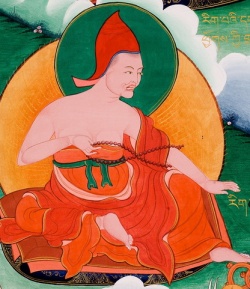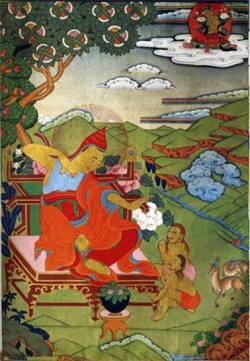A Restricted Interpretation of Dharmakīrti's Philosophy
The continuing surge in work on Dharmakīrti represents one of the most fertile enterprises within the field of Buddhist Studies.
The only South Asian philosopher to have been the subject of four international conferences, Dharmakīrti commands a veritable legacy of scholarship, whether directly, through the translation and study of his own works, or indirectly, through the study of his followers, commentators, and one-time opponents.
In the context of this burgeoning enterprise, characterized by a high degree of specialization, any attempt to bear on the totality of Dharmakīrti's thought is challenging at best and downright frustrating at worst. John Dunne's recent volume, Foundations of Dharmakīrti's Philosophy, meets this challenge in a novel and effective way.
Unlike most attempts to interpret Dharmakīrti, which deploy the lenses of his most influential commentators, Dunne proposes a "restricted" interpretation of his philosophy based on "the painstaking task of separating commentarial layers so as to learn the insights that characterize each commentator's work" (p. 11).
The primary intent of this work is thus to provide an overall perspective on the historical development of Buddhist thought as reflected in the pramāṇa literature.
While Dunne is committed to constraining his approach in "historical terms," he does not ignore its hermeneutical implications: the historical distance cannot be bridged without the interpreter's active participation in, and sharing of, some of the concerns and presuppositions that inform the Buddhist tradition, with the caveat that "reverence for an influential thinker" need not imply a willingness to "bow unconditionally at Dharmakīrti's feet" (p. 11).
Dunne starts with a reconstruction of the conceptual context of the pramāṇa discourse, with its emphasis on the analysis of the process of knowing. Here Dunne marks the difference between the early Naiyāyika philosophers Vātsyāyana and Uddyotakara, for whom the act of knowing involves a relation between the knowing agent and the object of knowledge, and Dignāga and Dharmakīrti, who conflate the cognitive event with the sources of knowledge.
The rest of this introductory section examines perception and inference (the two criteria of knowledge deemed reliable by nearly all pramāṇa theorists), concluding with a detailed review of the dispute over the ontological status of "real" particulars. These themes are then explored at length in the remaining three chapters of the book, starting with Dharmakīrti's method and ontology (chapter
2), continuing with his examination of the relation among the terms of a valid inference (chapter
3), and concluding with Dharmakīrti's extensive account of the purposive function (arthakriyā) of cognition (chapter
4). Dharmakīrti's principal work, the Pramāṇavārttika (and its autocommentary), along with the two early commentaries of Devendrabuddhi and Śākyabuddhi (and several other primary sources), are cited at length throughout the book. Dunne provides expanded portions of all these citations in a final appendix of translations--a useful addition that makes this volume one of the most comprehensive anthologies of primary sources for Dharmakīrti's philosophy in any modern language.
Dunne's main interpretive stance has it that Dharmakīrti's philosophical method relies on multiple descriptions of reality that appear to be mutually contradictory. This method, characterized by Dharmakīrti scholars as involving an "ascending" or "sliding" scale of analysis, reflects Dharmakīrti's pragmatic approach to ontological questions--an approach according to which different descriptions of reality can be seen as hierarchically structured.
[2] Scrutinizing Dharmakīrti's motives for the employment of such a method, Dunne contends that in some instances "a less accurate description is didactically or soteriologically preferable" (p. 53). Dharmakīrti's reliance on apparently contradictory ontological positions in his philosophical analysis is certainly not new.
His rationale is provided by the pragmatic need, encountered in nearly all Mahāyāna thinkers, of distancing their views from those of early Buddhists by incorporating the latter as provisional stages on the path to a higher understanding.
Rather than rejecting divergent or early views wholesale, this strategy of hierarchical inclusivism exploits the familiar Buddhist trope of "skill in means" (upāyakauśalya)--the Buddha's skill in addressing any given audience depending on its specific needs.
On the basis of a summary of Dharmakīrti's employment of this sliding scale of analysis, Dunne identifies, in ascending order, the following four specific positions: (1) the belief of ordinary persons, seen as the most basic and "most inaccurate description of reality";
(2) the Abhidharma typology, with its doctrines of the aggregate and momentary nature of phenomena, which represents a higher and more accurate description of reality;
(3) external realism, in the form of the theory of external things as unique, momentary particles--a view (generally associated with the Sautrāntika school) that postulates the existence of mereologically irreducible extra-mental entities; and
(4) idealism, the notion that all entities are mental. This highest level of analysis, associated with Yogācāra, is a view that relegates the subject-object duality to ignorance and essentially contends that "objects of awareness are internal" (p. 59).
While these four ontological positions encompass the whole range of Dharmakīrti's philosophical method, it is the defense of his peculiar notion of external realism that the sliding scale of analysis is apparently aimed at. Other than treating them as svalakṣaṇas, in the specific sense that term has for Buddhist pramāṇa theorists, Dharmakīrti's commentators generally disagree on the precise nature of external objects.
Dharmakīrti's extended treatment of the svalakṣaṇas, understood as irreducible real individuals and not as real properties of dharmas (as Vasubandhu sees them in his Abhidharmakośa), might suggest that Dharmakīrti is committed to external realism. Even so, Dharmakīrti's most frequently adopted position, that of external realism, is not held from an ultimate point of view.
Dunne's discussion of Dharmakīrti's use of external realism is further framed by an analysis of the objects of cognition (prameya), which concludes with a detailed exposition of the apoha doctrine in its specifically Dharmakīrtian formulation.
On Dunne's interpretation, the operation of apoha gives us the "isolated," the "extracted" and the "excluded," that from which all others have been excluded, in other words, "an utterly unique entity" (p. 133).
Thus, while Dharmakīrti's main opponents, the Naiyāyikas, would regard universals as real and essential to bridging the gap between perception and cognition, Dharmakīrti himself sees them as pragmatically efficient (or, to use Dunne's felicitous terminology, as performing a "telic" function) in their heuristic role: aids that help reach the only true real--the particular itself.
In unpacking the epistemological implications of the apoha doctrine, Dunne develops a noteworthy discussion of a threefold definition of the particular by Śākyabuddhi, which is also an explanation of the function of the Sanskrit compound anyāpoha. First, the particular or the excluded (the vyāvṛtta) is "that from which other is excluded."
Second, the gesture by which the particular is excluded, i.e., the exclusion itself (vyāvṛtti), is simply the "exclusion of the other." Third, the cognitive image or the internal representation is what provides the support for the exclusion of the other (p. 133).
Dunne examines the implications of this threefold interpretive schema for each of the four problems that any apoha-theorist must address: the relation between the universal and the particular; the universal's extension or "distribution," which allows it to apply to all the members of a given class of particulars; the question of what mental content, if any, corresponds to the particular, especially when negatively construed (as the "absence" of the other); and the role of mental image in the construction of universals.
Coming to terms with Dharmakīrti's unique account of the role of mental images in the construction of universals, Dunne takes recourse to Tillemans's proposal that we see Dharmakīrti as advancing a "theory of unconscious error," taken here to mean that, on Dharmakīrti's view, we effectively "mistake" the content of our conceptual cognitions, or our representations, for the actual particulars (p. 143).
The last two chapters of the book are devoted to a detailed analysis of Dharmakīrti's novel contributions, first, to obtaining reliable inferential knowledge, and second, to justifying the "instrumentality" (prāmāṇya) of the two sources of knowledge (perception and inference) accepted by the Buddhist pramāṇa theorists.
In the first case, it is well known that Dharmakīrti's innovations are centered on his interpretation of the relation among the different terms of an inference.
Responding to critics of Dignāga's triple inferential method (trairūpya), Dharmakīrti seeks to ground the pervasion relation (vyāpti) that obtains between the reason (hetu) and what is to be proved thereby (sādhya) on a stronger foundation than mere appeal to "observation and nonobservation."
Dharmakīrti's theory of the basis for inference thus centers on the notion of svabhāvapratibandha--the notion that there must exist some sort of nomological rule to control the relation between evidence and conclusion.
(Dunne interprets this to mean that the "conceptually constructed sameness that accounts for a correct judgement's reference" is based on the "nomological natures of causally efficient things" [p. 332f.].) This is one of the most technical aspects of Dharmakīrti's theory of inference, marked by his peculiar use of the notion of essential nature (svabhāva).
By forging a new, if at times idiosyncratic, technical vocabulary, including types such as "svabhāva-nature," "svabhāva-evidence" and "property-svabhāva," Dunne's schematic and comprehensive presentation does a good job of explaining the various aspects and implications of this theory for pramāṇa theorists.
Dunne's propensity toward "terminological habits" (p. 225) becomes all-pervasive in his discussion of the status of perception and inference as reliable sources of knowledge.
Here we are offered both a critique of the usage of current philosophical concepts in translating Dharmakīrti's ideas, and alternatives to prevailing terminological standards.
By his own admission, Dunne's rendition of prāmāṇya as "instrumentality" (based on its being a derivative form of pramāṇa, which Dunne sometimes renders as "instrument"), may not be well received in philosophical circles, where Dharmakīrti's ideas ought to have the most impact.
For Dharmakīrti, prāmāṇya pertains not only to "that which is a means of knowledge," but also to its result (pramāṇaphala), and to knowledge itself (pramā). "Instrumentality" would thus cover only one of the senses in which prāmāṇya is used by Dharmakīrti, that of "means" or "sources," leaving the resulting knowledge ("the truth") and the question of justification out.
As Dunne rightly points out "Dharmakīrti's discussion of prāmāṇya is more closely allied with questions of justification" (p. 225), but the issue of how to account for cognitions that are true, yet do not and cannot count as instruments of knowledge, remains problematic on a translation of pramāṇa as "instrument of knowledge."
Dharmakīrti's discussion of the cognitive function of universals is linked both to his theory of word meaning and to his pragmatics of purposive action (arthakriyā).
Whether we are dealing here with an externalist, reliabilist theory of justification or with an internalist, evidential theory of truth is open to discussion.
Dunne rightly points out that using "truth" or "validity" for prāmāṇya (and thus talking, for instance, about "valid perception") can either obscure or limit our understanding of whether or not we are dealing here with problems of justification and/or with a formal theory of truth (p. 225f).
In using "instrumentality" and epistemic "warrant" as equivalents for prāmāṇya and pramāṇa, respectively, Dunne shows greater sensitivity to current debates in epistemology than one usually encounters in the scholarly literature on Dharmakīrti, even though his analysis is largely confined to issues of textual analysis.
It could well be that the philosophical categories of neither epistemology nor logic exhaustively map the types of activities subsumed under pramāṇavāda.
Perhaps we are dealing here with attempts to devise a cohesive "cognitive theory" in the sense in which "cognitive" is currently used in cognitive psychology or in the sciences of cognition.
Either way, mere text-critical studies of his philosophical works will not afford Dharmakīrti (or, for that matter, any other South Asian philosopher) the kind of transparency required to make his ideas intelligible to a receptive Western philosophical audience.
Throughout this book, Dunne displays a commendable mastery of primary and secondary sources, and, given the semantic fluidity of Sanskrit technical terms, an admirable stylistic consistency.
Terminological issues aside, Foundations of Dharmakīrti's Philosophy stands as one of the most innovative and sophisticated attempts to engage with Dharmakīrti's project in a systematic way.
Source
Christian Coseru. Review of Dunne, John D., Foundations of Dharmakīrti's Philosophy.H-Buddhism, H-Net Reviews.June, 2010.
www.h-net.org


